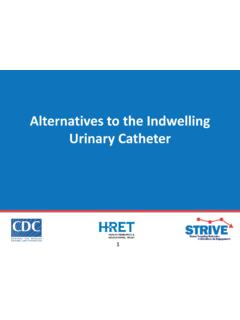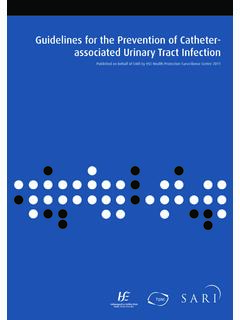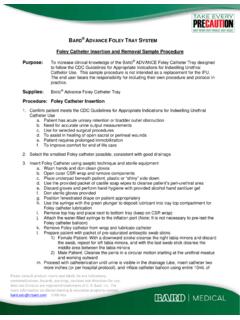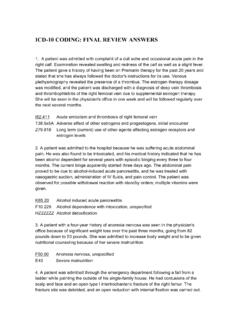Transcription of Appropriate Use and Prompt Removal of Indwelling Urinary ...
1 1 Appropriate Use and Prompt Removal of Indwelling Urinary Catheters PresenterJennifer Meddings, MD, MScAssociate Professor, Internal Medicine and PediatricsUniversity of Michigan Contributions byKristi Felix, RN, CRRN, CIC, FAPICM adonna Rehabilitation HospitalLinda Greene, RN, MPS, CIC, FAPICU niversity of Rochester, Highland HospitalMilisa Manojlovich, PhD, RN, CCRN University of MichiganSanjay Saint, MD, MPHU niversity of MichiganBarbara W. Trautner, MD, PhDBaylor College of Medicine Karen Fowler, MPHU niversity of Michigan2 Learning Objectives Describe when it is Appropriate to use Indwelling Urinary catheters for common clinical scenarios Use a daily checklist to reduce use of inappropriate Indwelling Urinary catheters in your unit Describe at least one reminder or stop order strategy for removing an unnecessary Indwelling Urinary catheter Describe at least two strategies to engage your staff in these CAUTI-prevention practices3 Tiers of CAUTI Prevention Practices4 Criteria for Appropriate Urinary catheter Use52009 criteria from HICPAC Guidelines andAmerican Nurses Association s Streamlined Evidence-Based RN Tool.
2 CAUTI Prevention2015 Ann Arbor Criteria for Appropriate Urinary catheter Use in Hospitalized Medical PatientsExample Indications Urinaryretention/obstruction Perioperative use for selected surgeries To assist with healing of open wounds in incontinent patients End-of-life care Critically ill and need for accurate measurements of I and O ( , hourly monitoring) Criteria for 3 catheter types: Indwelling , external and intermittent use catheters Includes 5-item Daily Checklist for reviewing Indwelling catheter use Refined clinical criteria accounting for pragmatic bedside challenges and optimizing use of alternatives Example: Indwelling catheters are Appropriate for measuring and collecting urine only when fluid status or urine CANNOT be assessed by other means Location in an ICU alone is NOT an Appropriate indication(Gould CV, Infect Control HospEpidemiol, 2010; ANA CAUTI Prevention Tool, ANA, Accessed 2016; Meddings J, Ann Intern Med, 2015)Should Your Patient Still Have an Indwelling Urinary catheter ?
3 6(Meddings J, Ann Intern Med, 2015)Daily Checklist for Indwelling Urinary catheter AppropriatenessChecklist Question 11. What is the urine volume measurement need? HOURLY urine volume measurement being used to inform and provide treatment? DA I LYurine volume measurement being used to provide treatment ANDvolume status CANNOTbe adequately assessed by daily weight or urine collection by urinal, commode, bedpan or external catheter ? 7(Meddings J, Ann Intern Med, 2015)Checklist Question the patient have a urologic problem that is being treated by an Indwelling Urinary catheter ?Examples: Urinary retention that cannot be monitored or addressed by bladder scanner/intermittent straight catheter (ISC) spinal cord injury Anticipated Urinary retention due to paralytic medications Recent urologic or gynecologic diagnosis or procedure for which catheter Removal is not yet recommended8(Meddings J, Ann Intern Med, 2015)Bladder Outlet Obstruction Decision Tree9(Meddings J, Ann Intern Med, 2015)Does patient with acute retention have bladder outlet obstruction?
4 YESNOC atheterAppropriate?IndwellingurinaryAppr opriateness varies by reason for obstruction. Consider urology consultation for prostatitis and urethral trauma, because may be better managed with suprapubic, or expert placement of Straight CatheterCatheterAppropriate?Indwellingur inaryYe sIntermittent Straight CatheterYe s ,if bladder can be emptied adequately by intermittent straight catheter every 4-6 hoursNote: External catheters are NOTappropriate in either case because they cannot address Urinary retention Use a bladder scanner to reduce number of catheterizations when no or little urine is seen in bladderChecklist Question 33. Is a urine sample needed that CANNOT be collected by other method such as urinal, external catheter or intermittent straight catheter (ISC)?10 Sample type?UseIndwelling Urinary catheter ? Use ISC?Use ExternalCatheter?Sterile sample for urinecultureNOYESYES, if stafftrained for sterile applicationNon-sterileurine sampleNOYESYES24-hour sampleYESYES, if all urine canbe collected by ISCYES, preferredoption in cooperative menPost-void residualmeasurementNONO, unless cannot be assessed by bladder scannerNO(Meddings J, Ann Intern Med, 2015)Checklist Questions the patient have Urinary incontinence that cannot be addressed by: Non- catheter methods ( , barrier creams, incontinence absorbent products) because nurses CANNOT turn and provide skin care with available resources ( , lift teams, lift machines) or Transition to external catheter for cooperative men?
5 11(Meddings J, Ann Intern Med, 2015)Incontinence Decision Tree12 Does incontinent patient have a skin issue?Is patient difficult to turn using available lift teams and devices? Indwelling Urinary catheter is APPROPRIATEfor open pressure ulcers (stages III-IV, unstageable) IF cannot be kept clean with wound dressings or alternative urine collection devices. INAPPROPRIATEfor incontinence-associated dermatitis and pressure ulcers stages I-II, closed deep tissue of Indwelling or ISC is INAPPROPRIATE, external catheter may be Appropriate for severe incontinence if patient requests while hospitalized. Indwelling Urinary catheters are Appropriate only IF unable to manage urine with other strategies such as external catheter , intermittent straight catheter (ISC), urinal, bedpan and other incontinence supplies: excess weight (>300 lbs) from obesity or edema, turning causes hemodynamic or respiratory instability, or strict temporary immobility post-op, such as briefly after vascular (Meddings J, Ann Intern Med, 2015)Checklist Questions the Indwelling Urinary catheter providing comfort from severe distress related to Urinary management that cannot be addressed by non- catheter options, intermittent straight catheter (ISC) or external catheter ?
6 Examples: Difficulty voiding due to severe dyspnea with position changes needed to manage urine without catheter Address patient and family goals for a dying patient Acute/severe pain upon movement with demonstrated difficulties using other Urinary management strategies 13(Meddings J, Ann Intern Med, 2015)Clinical Case 1 for Discussion14Ms. Johnson is a 45-year-old previously healthy woman who was admitted to the ICU with severe sepsis, requiring aggressive IV fluid resuscitation and vasopressor therapy. Does she need an Indwelling Urinary catheter (commonly known as a Foley)? , Indwelling Urinary catheter because admitted to the , because hourly urine output is being used to guide fluid resuscitation and vasopressor , because has no history of , as long as is able to urinate by other meansDisclaimer: All case studies are hypothetical and not based on any actual patient information. Any similarity between a case study and actual patient experience is purely Case 2 for Discussion15Mr.
7 Grant is a 66-year-old man who was admitted from the ED to the medical floor with a severe COPD exacerbation requiring BiPAP. Does he need an Indwelling Urinary catheter ? , Indwelling Urinary catheter because using , because hourly urine output is being used to guide fluid resuscitation and vasopressor , because has no history of , as long as is able to urinate by other meansDisclaimer: All case studies are hypothetical and not based on any actual patient information. Any similarity between a case study and actual patient experience is purely Case 3 for Discussion16Mr. Knight is a 25-year-old man with spinal cord injury who is currently admitted to a long-term acute-care hospital s spinal cord unit with Urinary retention. Which Urinary catheter strategies are Appropriate ? Urinary catheter straight catheter (ISC), In and Out or incontinence garmentsDisclaimer: All case studies are hypothetical and not based on any actual patient information.
8 Any similarity between a case study and actual patient experience is purely Case 4 for Discussion17 Mrs. Davies is an 80-year-old woman, admitted with syncope and awaiting pacemaker placement, who is admitted to a cardiac care unit, for a higher level of monitoring and nursing care than available on the standard medical unit. She has chronic Urinary incontinence and is a high fall orFalse: The nurse should insert an Indwelling Urinary catheter for Mrs. Davies because it will prevent skin breakdown and reduce her risk of fallingDisclaimer: All case studies are hypothetical and not based on any actual patient information. Any similarity between a case study and actual patient experience is purely Prolonged catheter Use Urinary catheters are often in place without physician awareness, and not removed promptly when needed 30%-50% of continued catheterization days found to be unnecessary Prolonged catheterization is the number one risk factor for CAUTI18 Traditional Steps to catheter recognizes catheter is recognizes catheter is no longer writes order to remove sees order and plans to remove the catheter is removed(Saint S, Am J Med, 2000; Hooton TM, ClinInfect Dis 2010; Foxman B, Am J Med, 2002)Strategies to Prompt catheter Removal19 Strategy TypeExamples1.
9 Reminders: Reminds that a Urinary catheter is still in use; may also remind of Appropriate indication to continue catheterization Daily checklist forevaluating Urinary catheters Sticker reminder on patientchart, catheter bag or electronic medical record (EMR) Orders: Prompts Removal of Urinary catheter based upon specified time after placement ( , 24 hours), based upon clinical criteria Remove in operating room (OR) before leaving/Routine post-op order Pre-op written or electronic order to remove Urinary catheter on post-op day 1-2 Nurse-empoweredremoval protocol In a review of 30 studies, these interventions reduced CAUTI significantly by 53% However, catheter reminders or stop orders were only used in about 50% of hospitals(Meddings J, BMJ Qual Saf, 2014; KreinSL, BMJ Qual Saf2015)Nurse, Physician, Team-Driven Strategies20 Example StrategyPhysicians Daily physician assessment of catheter need Computerized order entry system to Prompt physicians to remove/reorder catheter if placed in ED or in place >48 hoursNurses Nurse-led protocol to removeurinary catheters that do not meet criteria daily review by nurses for catheter indication Nurse-generated daily bedside reminders to encourage physicians to remove unnecessary Urinary catheters Nurse-to-nurse communication during transitions (ED, ICU): Does this patient have a Urinary catheter ?
10 Why? Team Multi-disciplinary rounds at the bedside Peri-procedural checklist and protocols for catheterinsertion that includeroutine Removal in the OR and post-opExample of a Nurse-Driven Protocol for catheter Removal (Appendix M. Example of Nurse-Driven Protocol for catheter Removal , AHRQ, 2015)Removing Urinary Catheters in Surgical Patients Standardizing post-op catheter Removal is criticalto reduce use Surgical checklists include a Procedure Time-Out of tasks for before the patient leaves the operating room (OR) For example: Catheters for OR procedures (such as laparoscopic with suprapubic port) can be removed before leaving the OR Patients with thoracic epidural catheters can have Urinary catheters removed, often within 48 hours after surgery Replace or remove Urinary catheters within 24 hours of placement if inserted emergently with suspected poor sterility21 Can invasive lines or catheters (including Urinary ) be removed?














